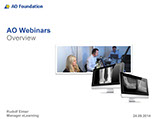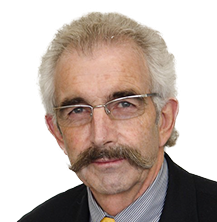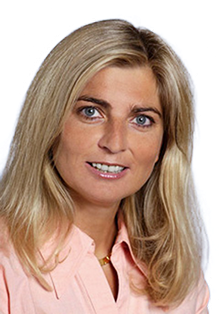AO webinars: learning and discussing with experts wherever you are
Webinars offer the unique opportunity to learn from world-renowned experts and discuss hot clinical topics in real time. AO conducts more than 40 webinars each year that are free of charge for all AO members.
Read an interview with Professor Jörg Auer
Read about Beate Hansons personal webinar-experience
Read about Diarmuid de Faoite's work as webinar–moderator
_________________________________
The difference between a webcast and a webinar?
A webcast is the broadcast of a recorded presentation over the Internet. The transmission of information is one-way only, from speaker to audience. Webcasts are not time-constrained so they can be viewed at any time, day or night.
A webinar is an interactive presentation over the Internet. The transmission of information works two-ways between speaker and audience. Through the use of technology the audience participates in the
presentation, can ask questions etc. Webinars are live and therefore they are time-constrained. In other words, you must be ready to participate in the webinar at a specific time and date.
_________________________________
Webinars in numbers:
40
number of webinars the AO Education Institute hosts each year
250
maximum participant number for each webinar
What is a webinar?
Webinars, interactive seminars conducted online, have become a popular mode of education. Webinars are usually provided as an online live video and can include a video showing the presenter, PowerPoint slides, video clips, and other media.
The ability of participants to view a webinar from anywhere in the world makes this an ideal way to reach large numbers of learners. Add in the interactive component (participants can ask questions and the presenter or a moderator can answer them and vice versa in real time) and webinars become a particularly powerful tool for interactive learning on a distance.
Webinars cost a lot less and can reach more learners than face-to-face meetings. The versatility of viewing options (computer, tablet, or smart phone) and the option to view a webinar live or at a later date also make them a great option for busy surgeons.
AO Foundation webinars
AO conducted its first webinar on pilon fractures presented by Christopher Sommer in 2010. AOTrauma was the first Clinical Division (CD) to conduct webinars, and the number of webinars has been growing at exponential rates ever since.
Currently, AO hosts over 40 webinars each year from the AO Education Institute (AOEI) in Dübendorf, Switzerland, and other regions are beginning to host their own webinars too. AOEI has designed a set of standards for webinars, which consists of an introductory presentation of approximately 40 minutes and then a question and answer session to finish out the hour.
Questions can also be asked during the presentation and are answered by the moderator. AO webinars typical consist of one surgeon presenting, but on occasion an expert discussion has been devised with up to four presenters.
Specialists assisting with your webinar
Diverse, evolving topics
Topics for webinars are decided by the CDs and scheduled throughout the year. Each CD announces webinars on their individual website and through email updates. When members register for a webinar they are provided with the log in information.
Webinars are free, but there is a limit to the number of people who can view a live webinar (usually around 250). For those who cannot make the live session, all webinars are also available online in the webinar and webcast library.
The future of webinars
AO is striving to make webinars more accessible to more learners in more places. AOEI is constantly refining the technology to make webinars more user friendly and globally functional. The goal is to have webinars be viewable and deliverable from any location. While this takes some technical know-how, it also entails standards for content and videography. To find out more about AO webinars, please visit the AO Foundation webinar and webcast page.
 "A great tool to reach out to people from all parts of the world."
"A great tool to reach out to people from all parts of the world."
Professor Jörg Auer, chairperson of the AOVET International Board, shares some personal tips on how to make your webinar successful.
How was the webinar you moderated received by its audience?
Really well, people from all over the world attended: Russia, Japan, Australia, India, Brazil, USA, Costa Rica, etc. It is exciting to know that you are speaking live to people from so many different countries. A webinar is a great tool to reach out to people from all parts of the world.
What is the key element of a good webinar?
It is the same as for a good lecture—the preparation. The support AO provides for webinars is very professional, which makes it easy for both the presenter and the moderator to do their jobs. One of the most important points I think is the rehearsal shortly before the live webinar. It helps to eliminate technical mistakes but can also greatly enhance the presentation of the surgeon.
How is it different from a regular lecture?
The most distinguishing feature certainly is the lack of a visible audience. You speak to a camera and the interactivity with the participants is limited to questions and answers from a few of them. You have no idea whether the majority of your participants are actually interested or fast asleep.
How do you deal with this?
I ignore the thought of sleeping participants and focus on my competence. The best webinars are those delivered by confident, knowledgeable lecturers who can captivate their audience by transferring this knowledge.
___________
ABOUT Jörg Auer Dr. med. vet. MS
Jörg Auer is the Chairperson AOVET International Board. He spent his early career in the United States at the Department of Large Animals Medicine and Surgery at Texas A&M (Agricultural and Mechanical) University. In 1989 he accepted a position as Professor of Veterinary Surgery at the University of Zurich and as Director of the Veterinary Surgery Clinic. Later he became Director of the Equine Hospital. Jörg Auer was recently the moderator of the Webinar "Fracture Management of the Head Region; Part II: Head and Skull - What can be done?"
Behind the scenes of an AO Webinar
Beate Hanson tells us what it is like to present a webinar …
Beate Hanson, Director of AO Clinical Investigation and Documentation, was invited to put together an entertaining webinar on an aspect of clinical research. Together with the moderator Diarmuid De Faoite she gives us an insight into the challenges they faced when delivering the webinar "The Clinical Research Casino – Statistical Concepts used in Gambling and Clinical Research.
When AOTrauma asked me to deliver a webinar I was very happy to accept, but little did I know about the amount of work that goes in to giving one. In a webinar the moderator is subject to a number of special pressures and distractions – will anyone join us? Will they ask enough questions? Will I be able to answer them straight away? Will all the technology work well? Can I cope with simultaneously giving the presentation, looking in the camera, reading the questions that come in and following the off camera instructions that my moderator or technical support may give?
The practice run we did brought home to me how difficult it is to cover all these bases and still appear unflappable to anyone watching. Not having a “live” audience in front of me but knowing that around 100 people are following your lecture closely was a very odd experience for someone who has given many lectures and lessons to “live bodies”. Rudolf Elmer from the AO Education Institute very patiently schooled me with some tips to try and improve my webinar presentation techniques. The second run-through then went much more smoothly and helped me to calm my nerves about the whole issue.
The next day was the day of the webinar. That morning we did a full dress rehearsal with some AO people joining us online to view the webinar. The minutes before we began were quite nerve-wracking. Slowly we watched the online room fill up, our first participant, our tenth participant, I could not believe it as I counted representatives of over 40 countries. When we began there were around 70 participants and that number kept climbing to about a 100 with people from Oman, Nigeria, the USA, India, Venezuela – I could scarcely believe the global audience we were reaching thanks to new technology.
Once I began with the presentation proper I soon forgot about the strangeness of the experience and got into "teaching mode". In fact, I was so involved in giving the webinar that I was really surprised when I got to the question and answer session and realized that the 40 minutes of presentation time had already passed. I then took great heart in seeing that 57 webinar participants took the time to leave positive comments in the chat box open once the session had finished.
I would advise anyone who is going to give a webinar for the first time to make sure they schedule enough time for a few practice runs. It is also very important that you have webinar team members you can rely on for advice and support. Although superficially similar, it is a completely different experience to presenting at congresses or standing in front of a “live” class full of students. But it is also an experience I am really glad to have made!
 … and the moderator Diarmuid De Faoite talks about the challenges of being the man in the background
… and the moderator Diarmuid De Faoite talks about the challenges of being the man in the background
When I was asked to comoderate the webinar I was very excited to be involved in a new experience. After all, I was not going to be the one the camera was on, how hard could it be? The answer was very hard indeed!
I had been lulled into a false sense of security in the run-throughs we did because it was impossible to replicate the real-time experience of questions whizzing in from all around the world. In the practice runs I had simply posed Beate a few questions I had prepared myself. During the live webinar I asked people to send in their questions but they came in only in drips and drabs. With the benefit of hindsight I know that this was because they were too engrossed in the presentation to chat with me.
But during the webinar itself I was rather nervous. Did I send my private message to the right person? Did I manage to send a reminder to everyone to send in their questions? People kept writing test messages which I answered to let them know that everything was functioning perfectly.
However, once the questions and answers session began I suffered from question overload. The chat window began to fill up quickly as the questions whipped in from across the globe.
I had little time to reflect on each one. As quickly as possible I had to evaluate whether the question had already been covered in the webinar, whether it was possible for Beate to answer it on the fly (some of the questions were so specific that it would have taken too long to work out, I asked these people to contact us after the webinar). In addition, since English was not the first language of many of the participants and people were typing quickly I also had to make some fast edits to try to make it as easy as possible for Beate to understand the questions.
Having worked in radio I know that the worst possible thing is for there to be “dead air” - ie, time when nothing is being said. I had to try to keep feeding Beate with questions to avoid this happening plus I also had to offer her a choice of questions so that she could pick the one she felt most comfortable with. Obviously the person giving the webinar is under the most pressure and the support team should be there to reduce any additional stress.
Based upon my experiences over the two days I can definitely say that organizing and giving a webinar involves a steep learning curve for everyone doing it for the first time – even for the moderator in the background.
Further information
Once some postediting has been carried out, an archived version of the webinar will be made available here:
http://www.aovideo.ch/catalog/ -> Search by Category -> Webinars
It is also planned to hold a number of webinars, including a second live repeat of Beate Hanson's webinar, during the AO Courses in Davos in December this year.
AOSpine
www.aospine.org | education@aospine.org
Copyright © 2014 AO Foundation. All rights reserved.




